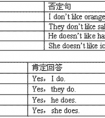改错。 ( ) l. My birthday is on first of April. _____ AB CD( )2. I'd like to some balloons. _____ A B C D( )3. Does Ben and his brother like cartoons? ___-六年级英语
题文
| 改错。 |
|
( ) l. My birthday is on first of April. _____ |
答案
| 1. C; the first 2. B; like 3. A; Do 4. B; talking 5. B; does |
据专家权威分析,试题“改错。 ( ) l. My birthday is on first of April. _____ AB C..”主要考查你对 定冠词(the),现在进行时,现在分词,实义动词,助动词 等考点的理解。关于这些考点的“档案”如下:
定冠词(the)现在进行时,现在分词实义动词助动词
考点名称:定冠词(the)
- 冠词:
是英语所特有的词类,在汉语中是没有冠词这一说的。虽然它看起来简单,左右不过是a,an,the三个单词,但是正因为中国人的语言习惯大不相同,要彻底掌握和用好冠词,还是不容易的。
冠词分为定冠词(the)和不定冠词(a,an)。它们都置于名词之前,用来说明名词所表示的人或事物。它们不能离开名词而单独存在。 定冠词the的使用情况
A、表示一类人或事物中的某一个或某一些。不论单数名词或复数名词,也不论该名词是否可数,
前面都可以用the。
B、特指某人或某事之前用the。例:The girl under the tree is my sister.
C、指说话人与听话人都熟悉的人或事之前用the。
D、形容词最高级和序数词之前要用the。the best,the first。
E、表示世界上独一无二的事物之前要用the。the Great Wall。
F、重复上文中提到过的人或事用the。- 定冠词的用法口诀:
特指双熟悉,上文已提及;
世上独无二,序数最高级;
某些专有名,习语及乐器。
作为定冠词的基本用法,在下列三种情况下,名词前一定要加the。
第一,当名词所指的东西已经非常明显;
第二,前面已经提到的名词,再次提到时;
第三,当该名词由短语或从句所修饰时。举例如下:
e.g. My friend is waiting for me at the end of the street. (所指的街道说话人和听话人都知道)
e.g. Once upon a time, there was a temple. A monk living in the temple was very kind. (‘temple’在上文提到过,所以再次出现时,要加the)
e.g. This is the book I promised to lend you. (‘the book’由后置定语从句修饰,要加the)
从上面的例子可以看出,这三种情况最根本的要点是当名词有明确所指时或明显被限定时,一般要用the。也就是说,这里强调了the的特指作用。
另外还有两种the的固定用法也强调特指:当用在独一无二的宇宙天体之前(如:the sun, the sky),及用在某些专有名词之前(如:the Yellow River, the Times, the Ministry of Education)等。
考点名称:现在进行时,现在分词
现在进行时:
表示动作发生的时间是“现在”,动作目前的状态是“正在进行中”。所谓“正在进行中”,是指在谈到这件事的时候,这个动作还在进行中。
现在进行时由“系动词am/ is/ are+动词-ing形式”构成。
例:We are reading the text. 我们正在读课文。
My sister is working in a hospital. 我的妹妹在医院工作。
They are watching TV now. 他们正在看电视。
What are you doing, Li Lei? 你现在正在干什么,李雷?- 现在进行时的基本用法:
A表示现在( 指说话人说话时) 正在发生的事情。
例:We are waiting for you.
B. 表示现阶段正在进行的动作,说话时未必正在进行。
例:Mr. Green is writing another novel.
(说话时并未在写,只处于写作的状态。)
例:She is learning piano under Mr. Smith.
C.已经确定或安排好的但不确定会不会发生的将来活动。
I'm leaving for a trek in Nepal next week.(我下周要去尼泊尔旅行)
We're flying to Paris tomorrow.(我们明天乘飞机去巴黎) 一般现在时与现在进行时的区别:
一、准确理解两种时态的主要含义:
(一)一般现在时:
1.表示事物的本质特性或客观存在,没有时限性。
The table ____ soft。(feels) 表特性特征。
Japan ___ in the east of China。 (lives) 表客观事实
2.现阶段经常性、习惯性的行为,可带频率时间。
The shop closes at 7:30 p.m.
Father doesn’t smoke. (习惯)
3.表说话时的状态,感觉或结果,一般用状态动词,如:It doesn’t matter. Does it hurt? (感觉结果)
4.特殊用法:
-在条件、时间、让步从句中用现在时代替将来。
-If you go there,I’ll help you.
—用在begin,come,go,leave,return,open,close 等短暂谓语动词表规定计划。
The plane takes off at 11:30. (不受主观支配的计划)
-在剧本、解说、标题或there(here)开头的句中表进行
There goes the bell/Here comes Mr.Wang.
I declare the meeting opens.(正在宣布)
He meets the ball and hits back to No.2 (正在发生)
(二)现在进行时:
1.说话时正在发生,进行的动作
Look! Dark clouds are gathering . (正在发生)
2.表现阶段正在进行,但此刻不一定正在进行的事。
He usually gets up at 6:00,but this week he is getting up at 7:00. (现阶段正在进行,但说话时不一定在起床)
3.现在进行时的特殊意义
-表示主观打算常用于 go,come,leave,start,begin 等,位移、趋向动词。
How long are you staying here (准备停留)
-表示眼前刚过去的语意即“话音刚落”,适用于tell,say,talk,discuss ….
- 最新内容
- 相关内容
- 网友推荐
- 图文推荐
| [家长教育] 孩子为什么会和父母感情疏离? (2019-07-14) |
| [教师分享] 给远方姐姐的一封信 (2018-11-07) |
| [教师分享] 伸缩门 (2018-11-07) |
| [教师分享] 回家乡 (2018-11-07) |
| [教师分享] 是风味也是人间 (2018-11-07) |
| [教师分享] 一句格言的启示 (2018-11-07) |
| [教师分享] 无规矩不成方圆 (2018-11-07) |
| [教师分享] 第十届全国教育名家论坛有感(二) (2018-11-07) |
| [教师分享] 贪玩的小狗 (2018-11-07) |
| [教师分享] 未命名文章 (2018-11-07) |


![Mrs Smith can _____ piano. [ ]A. play the B. playedC. plays the -六年级英语](http://www.00-edu.com/d/file/ks/4/1/19/2019-08-14/small7dd443171fd8fd01bff0ec5b631cd2a41565791318.jpg)

![Look! Thetwo are __________.[ ]A. thedifferent B. different C. thesame-四年级英语](http://www.00-edu.com/d/file/ks/4/1/19/2019-08-14/smalle5a45634611c2390d8031c73d46000df1565791186.gif)
